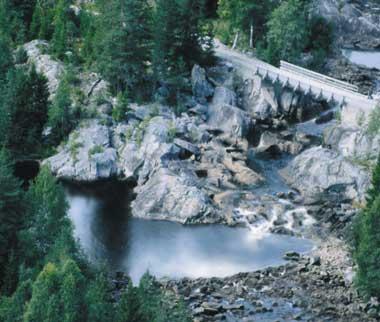Mitigation measures

The developer has already implemented a number of mitigation measures in the proposed plan, based on input from land owners and the independent expert groups that have carried out impact assessments.

The developer has already implemented a number of mitigation measures in the proposed plan, based on input from land owners and the independent expert groups that have carried out impact assessments.
Minimum flow is an important mitigation measure for the natural environment, particularly for vegetation and fish, but also for the public’s experience of the landscape. In Hjartdøla river, a release of 1,000 l/s* in summer and 500 l/s in winter is planned from the intake at Hjartsjå.
From the intake at Sønderlandsvatn lake, 360 l/s will be released in summer and 100 l/s in winter. The minimum flow in Skogsåa river cannot be guaranteed during long periods of drought and periods of very low inflow. Release of the minimum flow will be important during dry periods for both Hjartdøla and Skogsåa rivers. The minimum flow at Sauland Power Plant will be higher than before the development, since some of the reservoirs will be used to secure the minimum flow.
The developer will supplement the minimum water release from Hjartsjå, to ensure that a minimum flow from Omnesfossen waterfall of 2,500 l/s in the summer and 1,000 l/s in the winter can be observed.
A separate environmental follow-up programme will be prepared. A number of the mitigation measures proposed in the environmental impact assessments are important considerations, and will be included in the development of the detailed engineering plans and environmental follow-up programme.
The plans for the intake by Sønderlandsvatn lake include a landscaped rest area. This will give the area an ‘aesthetic boost’, according to the report Fagrapport Landskap.
Areas for spoil heaps have been selected with a view to minimising their visual impact. The spoil heaps have been designed to blend into the landscape as well as possible. The shape and placement of the Lonargrend spoil heap have been adjusted to minimise conflict with the adjacent hayfield. This adjustment also takes into consideration the clearance cairns that have been identified in the area.
The pressure in Sauland Power Plant’s wells will be monitored. Large areas of Sauland Power Plant’s tailrace tunnel containing water-bearing cracks are set to be repaired. If the water level in the ground water reservoir nonetheless falls, then smaller areas with water-bearing cracks must also be repaired.
Temporary and any permanent changes in capacity/quality of private drinking water sources caused by the measure will be followed up and remedied where necessary.
The dams at Hjartsjå and Sønderlandsvatn will be designed with a fish pass to allow eel to move both up and down the watercourse.
After the plant is built, water-covered areas will be monitored/studied during summer and winter, along with the living conditions for freshwater pearl mussels and trout. These studies will form the basis for any mitigation measures, such as weirs.
The developer has agreed to establish rock weirs to the degree that this will be a positive environmental measure. After an assessment of pros and cons, the Norwegian Water Resources and Energy Directorate will determine where and how the weirs will be established.
Postboks 80
3901 Porsgrunn